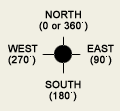Pollutant Data
Particulate (PM10)
PM
10 particles are less than or equal to 10 micrometers in diameter.
They tend to have a natural origin and are made of dust, dirt, and liquid droplets.
Sources of PM
10 particles include dust stirred by wind and/or
vehicles traveling on unpaved roads, and crushing and grinding operations.
PM
10 particles include PM
2.5 particles (described below).
Particulate (PM2.5)
PM
2.5 particles are less than or equal to 2.5 micrometers in diameter.
They tend to have a manmade origin and are particularly efficient at scattering visible light, causing visible haze conditions.
PM
2.5 particles are typically sulfates and nitrates formed from oxides of sulfur and nitrogen emitted during combustion of fossil fuels.
Particulates are measured with a Tapered Element Oscillating Microbalace (TEOM) which measures the mass of PM
10 and PM
2.5 particles.
The particles in the sample air stream are separated by size prior to measurement. The sample air stream is heated to remove humidity.
Ozone (O3)
Ozone is a gas composed of three oxygen atoms.
It is not usually emitted directly into the air, but is created at ground level
by a chemical reaction between oxides of nitrogen (NO
x)and volatile organic
compounds (VOC) in the presence of heat and sunlight. Ozone has the same
chemical structure whether it occurs miles above the earth or at ground level
and can be "good" or "bad," depending on its location in
the atmosphere. "Good" ozone occurs naturally in the stratosphere
(approximately 10 to 30 miles above the earth's surface) and forms a layer that
protects life on earth from the sun's harmful rays. In the earth's troposphere,
ground-level ozone is considered "bad."
VOC + NOx
+ Heat + Sunlight = Ozone
Ozone is measured using a NIST and U.S. EPA standard dual cell ultraviolet photometric technique to yield ozone measurements up to 200 ppm.
Meteorological Data
Temperature
The ambient air temperature measured in degrees Fahrenheit.
Relative Humidity
The ratio of water vapor in ambient air compared to the maximum amount of water
vapor that could occur at the ambient air temperature. The ratio is measured as a percent.
Wind Speed
Wind velocity measured in miles per hour.
Wind Direction
Wind direction is the direction from which the wind is blowing. It is measured using
a compass scale of 0 to 360 degrees. North is 0 or 360 degrees, East is 90
degrees, South is 180 degrees, and West is 270 degrees. See diagram.
 Precipitation
Precipitation
Total amount of rainfall accumulated (measured) in inches per 24-hour period.
Air Quality Standards
EPA AirNow at
www.airnow.gov